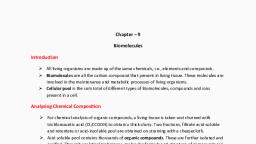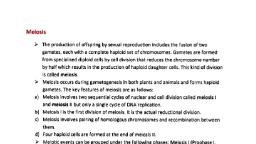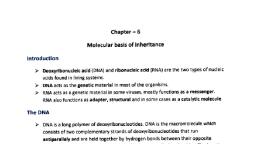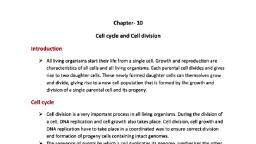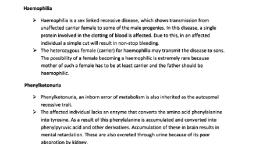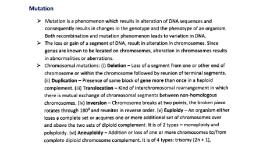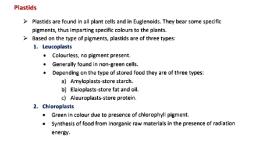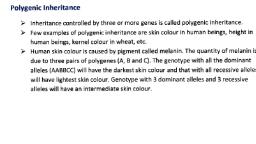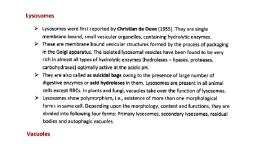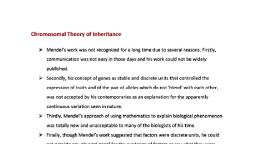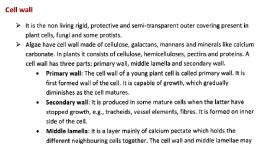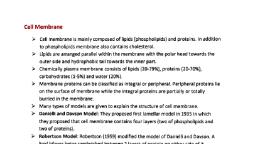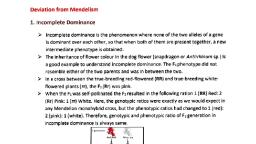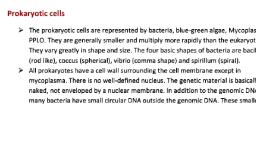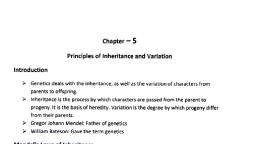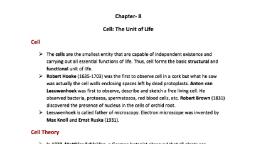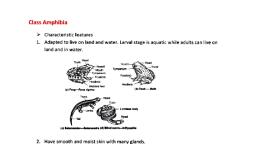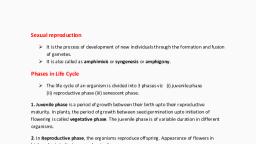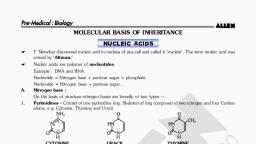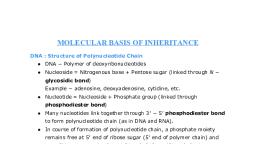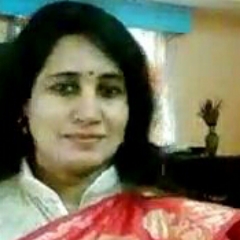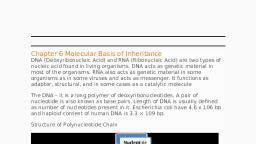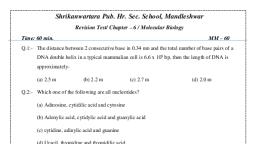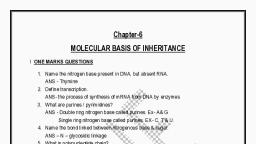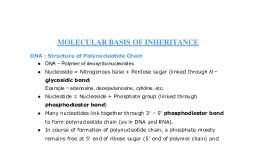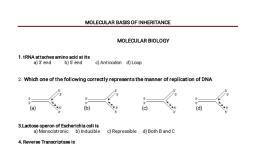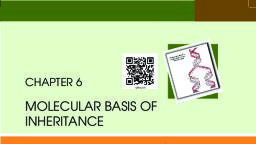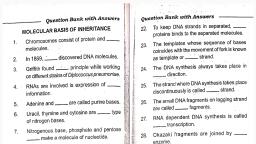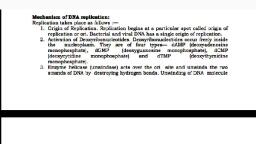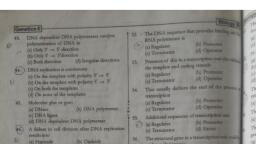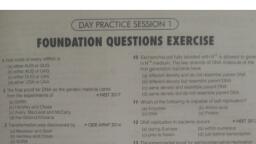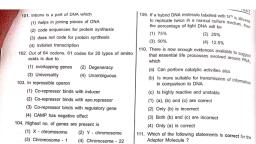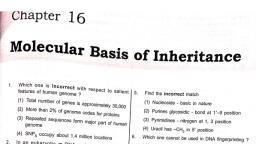Page 1 :
RNA world, RNA was the first genetic material. RNA used to act as a genetic material as well as a, catalyst. RNA being a catalyst was reactive and hence unstable., , >DNA has evolved from RNA with chemical modifications that make it more stable., DNA being double stranded and having complementary strand further resists, changes by evolving a process of repair., O n the basis of molecular size and function, three main forms of non-genetic RNA, are- mRNA, tRNA and rRNA. mRNA constitutes about 3.59% of cellular RNA; tRNA is, about 15% and rRNA about 80%., ., , Messenger ribonucleic acid (mRNA) or informational RNA or template RNA is, , a molecule of RNA that is transcribed from a gene and then translated by, ribosomes in order to manufacture protein., i., , tRNA or transfer RNA is also known as soluble(s) RNA, acceptor RNA or, , adapter RNA. Which consists of AA-bindingsite., , Ser, , Amino cid, **eplor end, , Variabde arm, , Anticodou, loop, Anncodon, , m-RNA, , Fig.: A diagram of tRNA, , Ribosomal RNA is a component of the ribosomes, the protein synthetic, factories in the cell. It is formed in nucleolus.
Page 2 :
Replication, The unique process of making an identical copy of a double stranded DNA, using, existing DNA as a template for the synthesis of new DNA strands is called DNA, replication., , The Experimental Proof (Meselson and Stahl Experiment), Matthew Meselson and Franklin Stahl in 1958 proved that DNA replicates by semiconservative method by experimenting on E.coll and used the heavy isotopes of, nitrogen, i.e., 1N. They grew bacterial cells having DNA labeled with 5N in 4N, medium and found that Figeneration has DNA density intermediate between the, two. Thus, the newly synthesised DNA possesses ane strand contributed by parent, DNA and other newly synthesised., GEN RATNON, , MERATON, , "NONA, , NONA, , NOA, , NDNA, , XX, , X 20 min, , 4DNA, , X min, NONA, , Gravitationalforce, D, ' N "w"w, , N, , eparatiorm ot DRA DY Centrugation), , Fig.: Meselson and Stahll's Experiment, , Very similar experiments involving use of radioactive thymidine to detect, distribution of newly synthesised DNA in the chromosomes was performed on Vicia, foba by Taylor and colleagues in 1958. They proved that the DNA in chromosomes, also replicate semi-conservatively., , The Machinery and the enzymes, Replication of DNA is energetically highly expensive. In E.coli, the process of, replication requires a set of catalysts (enzymes). The main enzyme is referred to as, DNA-dependent DNA polymerase, since it uses a DNA template to catalyse the, polymerization of deoxynucleotides. These enzymes are highly efficient enzymes as, they have to catalyse polymerization of a large number of nucleotides in a very short, time. E.coli that has only 4.6 x 10 bp, completes the process of replication within 18, , minutes. Any mistake during replication would result into mutations., Replication requires abundant energy that comes from breakdown of triphosphates, of deoxyribonucleotides. Enzyme helicase acts over the Ori site and unzips the two, , strands of DNA. The separated strands are stabilized by means of single stranded, binding proteins (ssBPs). Unwinding creates tension in the uncoiled part by forming, more supercoils. Tension is released by enzymes topoisomerases. They cause, nicking of one strand of DNA and resealing the same. Whole of DNA does not open, in one stretch due to very high enerey requirement but the point of separation
Page 3 :
proceeds slowly towards both the directions. It gives the appearance of Y-shaped, structure called replication fork. A small strand of RNA, called RNA primer, is, , synthesised at the 5" end of new DNA strand. It is essential for initiation of new DNA, chains as it is required by DNA polymerase to add nucleotides. DNA polymerase, , catalyses polymerization only in one direction, i.e., 5 ' 3 ' . Consequenty, on one, strand (the template with polarity 3'+5), the replication is continuous, while on, the other (the template with polarity 5 3 ) , it is discontinuous. Discontinuous, , replication ocurs because only a small stretch of template exposes at a time. The, , discontinuously synthesised fragments are later joined by the enzyme DNA ligase., , Template DNA, (parental strands), , Continuous, , Discontinuou, , Synthesis, , 5ynthesis, , Newly synthesi sed, strands, , Fig.: Replicating fork, , There is a definite region in E.coli DNA where the replication originates. Such regions, are termed as origin of replication. In eukaryotes, the replication of DNA takes place, at S-phase of the cell-cycle., , Transcription, T h e process of copying genetic information from one strand of the DNA into RNA is, , termed as transcription. The principle of complementarity governs the process of, transcription, except the adenosine now forms base pair with uracil instead of, , thymine. In transcription only a segment of DNA and only one strands is copied into, RNA., , A transcription unit in DNA is defined primarily by the three regions in the DNA: (i) A, , promoter, (i) The structural gene, (ii) A terminator., Transcription requires an enzyme RNA polymerase. The entire or complete enzyme, , (holoenzyme) consists of a core enzyme and a sigma factor (o). The sigma factor, recognizes the start signal on DNA and directs the binding of the enzyme to the, promoter region. It thus enhances the specificity of transcription., >It takes place in the following three steps:, a. Initiation: The RNA polymerase holoenzyme first recognizes the promoter at the, -35 region and binds to the full promoter. As initiation continues, RNA, polymerase binds more tightly to the promoter at the -10 region, accompanied, by a local untwisting of the DNA in that region.
Page 4 :
b. Elongation: After eight to nine nucleotides have been polymerized, the sigma, factor dissociates from the core enzyme. As the RNA polymerase elongates the, , new RNA chain synthesised from 5, , 3 end, the enzyme untwists the DNA, , ahead of it, keeping a single-stranded transcription bubble spanning about 25bp., About 9 bases of the new RNA are bound to the single-stranded DNA bubble,, with the remainder exiting the enzyme in a single-stranded form., , C. Termination: As polymerase transcribes away from the promoter, rho factor, binds to RNA and follows the polymerase. When polymerase reaches some sort, of pause site, rho factor catches up with polymerase and unwinds the DNA-RNA, , hybrid, resulting in release of polymerase., DNA hel, , lottiation"P, , a, , ,DO, , inator, , HeNA, , Eongation, , DDOOD, ennaton, RNA, Rho Lacto, , Fig.: Process of transcription in bacteria, , Post transcriptional modification, Transcription in eukaryotes occurs within the nucleus and mRNA moves out of the, nucleus into the cytoplasm for translation. The mRNA is processed from the primary, , RNA transcript, a process called maturation. Initially at the S' end, a cap anda tail of, poly A at the 3 end are added. The cap isa chemically modified molecule of, guanosine triphosphates. The primary mRNA transcript is longer and localised into, , the nucleus, where it is also called heterogenous nuclear RNA (hnRNA) or pre, mRNA. The primary mRNAs are made up of two types of segments; non-coding8, introns and coding exons. The introns are removed by a process called RNA splicing., The enzyme ligase joins two adjacent exons to produce mature mRNA., , m RNA, , Capping, Cap, , ntro, Polyadenylation, , Exon, , RNA splicing, , o, , 99, , Poly A tail, , Messenger RNA (m RNA), , Fig.: Post transcription modification
Page 5 :
Genetic code, The genetic representation of codon by which the information in RNA is decoded in a, , polypeptide chain is called genetic code. It is the relationship of amino acid, sequences in a polypeptide chain and base sequences of DNA. George Gamow,a, , physicist, argued that since there are only 4 bases and if they have to code for 20, amino acids, the code should constitute a combination of bases. He suggested that in, , order to code for all the 20 amino acids, the code should be made up of three, , nucleotides. A permutation combination of 4 (4x4x4) would generate 64 codons., The chemical method developed by Har Gobind Khorana was instrumental in, , synthesizing RNA molecules with defined combinations of bases. Severo Ochoa, enzyme was also helpful in polymerizing RNA with defined sequences in a template, , independent manner., , Genetic, , code has following characteristics:, , Genetic code is universal, i.e., found in all living organisms. E.g., from bacteria to, ii., , human UUU would code for phenylalanine., For a particular amino acid, more than one code can be used. This is called, , degeneracy of codon., ii., , Genetic codes are non-overlapping, i.e., same letter cannot be used for two, , different codons., iv., , A, , particular codon, , will, , always, , code for, , same, , amino, , acid, i.e., code, , is, , non, , ambiguous. But GUG, when present in intermediate position codes for valine., ., , I., , The codon which initiates the protein, AUG which codes for methionine., , synthesis is called initiator codon., , It is, , mosthy, , The codons which do not code for any amino acid are called non-sense codons or, , terminator codons. Three codons, viz. UAG (amber), UAA (ochre), and UGA, (opal), are non-sense codons., Second Positon, , G, , OCeuCC, UG, , JAC, , CCU, , Hs, , CG, , Gh, , UU, , G, , CCG, Ser, , UC, UA, , ADG, , Vet, , GUU, , Table: The codons for the various amino acids, , Wobble hypothesis was given by F.H.C. Crick (1965). According to this, third, nitrogenous base of a codon binds loosely with anti-codon and codon is mainly, , specified by first two bases. Hence, the same tRNA can recognise more than one, codons, , differing only, , at, , third, , position.
Page 6 :
Mutations and Genetic Code, A classical example of point mutation is a change of single base pair in the gene for, , beta globin chain that results in the change of amino acid residue glutamate to, valine. It resuts into a diseased condition caled as sickle cell anemia., , Insertion or deletion of one or two bases changes the reading frame from the point, of insertion or deletion. Such mutations are referred to as frameshift insertion or, deletion mutations. Insertion or deletion of three or its multiple bases insert or, delete in one or multiple codon will unaltered the reading frame. This forms the, , genetic basis of proof that codon is a triplet and it is read in a contiguous manner., , Non-sense mutation: In this, mutation stops protein synthesis due to formation of, non-sense or stop codon, e.g., UUA, , UAA., , Mis-sense mutation: In this, mutation changes the codon that produces different, amino, , UUU., , acids, e.g., UUA, , Same sense mutation: It is silent mutation in which codon is changed but amino acid, is not, , changed due to degeneracy of genetic code, e.g., UUA, , UUG., , tRNA the Adapter Molecule, Francis Crick postulated the presence of an adapter molecule that would on one, hand read the code and on other hand would bind to specific amino acids. The tRNA, is also called sRNA., , IRNA -, , URNA-, , UcA Anticodon, , AU, , A, , mRNA, , Codon, , Fig.: tRNA -the adapter molecule, , The secondary structure of tRNA has been depicted that looks like a clover-leaf. In, actual structure, the tRNA is a compact molecule which looks like inverted L. tRNA, has an anticodon loop that has bases complementary to the code and it also has an, , amino acid acceptor end to which it binds to amino acids. tRNAS are specific for, each amino acid. For initiation, there is another specific tRNA that is referred to as, initiator tRNA. There are no tRNAs for stop codons.

